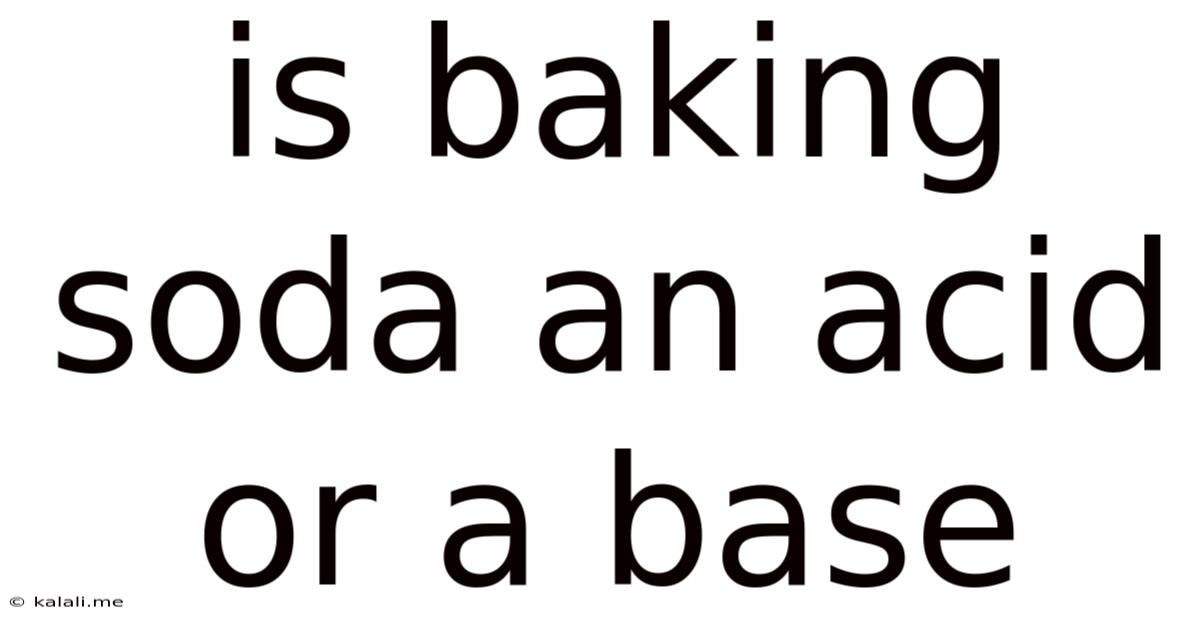Is Baking Soda An Acid Or A Base
Kalali
Jun 10, 2025 · 3 min read

Table of Contents
Is Baking Soda an Acid or a Base? Understanding pH and Baking
Baking soda, a common household ingredient, is often associated with baking and cleaning. But understanding its chemical nature—whether it's an acid or a base—is key to appreciating its diverse applications. This article will explore the chemical properties of baking soda, explaining why it's considered a base and how this property contributes to its effectiveness in various contexts.
Baking soda, chemically known as sodium bicarbonate (NaHCO₃), is definitely a base. This means it has a pH greater than 7, indicating its alkaline nature. Unlike acids which release hydrogen ions (H⁺) in solution, bases release hydroxide ions (OH⁻) or accept hydrogen ions. Baking soda's alkaline nature is the reason behind its numerous uses, from neutralizing acids in baking to cleaning and even personal care applications.
Understanding pH and the pH Scale
The pH scale is a logarithmic scale ranging from 0 to 14, measuring the acidity or alkalinity of a substance. A pH of 7 is considered neutral (like pure water). Substances with a pH below 7 are acidic, while those with a pH above 7 are alkaline or basic. The further a substance is from 7 on either end of the scale, the stronger its acidity or alkalinity.
Baking soda has a pH of around 8.3, firmly placing it in the alkaline range. This relatively high pH is responsible for its ability to neutralize acids.
How Baking Soda Works as a Base
The alkalinity of baking soda stems from its ability to react with acids. This reaction produces carbon dioxide gas (CO₂), water (H₂O), and a salt. This process is crucial in baking:
-
In baking: When baking soda reacts with an acidic ingredient (like buttermilk, lemon juice, or vinegar), the carbon dioxide gas produced creates bubbles, resulting in a light and airy texture in baked goods. This is a classic acid-base reaction, resulting in the leavening effect. Understanding this reaction helps in choosing the right leavening agents for different recipes. Recipes often call for both baking soda and baking powder (which contains an acid).
-
Cleaning: The basic nature of baking soda allows it to neutralize acids, making it effective in cleaning applications. It can be used to remove grease and grime, and to deodorize surfaces by neutralizing odor-causing acids. This makes it a versatile and environmentally friendly cleaning agent.
-
Other Applications: The unique properties of baking soda extend beyond baking and cleaning. Its mildly abrasive nature and ability to absorb odors make it a useful ingredient in personal care products like toothpaste and deodorants.
Baking Soda vs. Baking Powder: A Key Distinction
While both baking soda and baking powder are leavening agents, they differ significantly in their composition and how they work. Baking soda is pure sodium bicarbonate, requiring an acidic ingredient to activate. Baking powder, on the other hand, is a mixture of baking soda and an acid, already containing the necessary components for leavening. Knowing this distinction is crucial for successful baking. Choosing the correct leavening agent is dependent on the recipe and the presence of acidic ingredients.
In Conclusion: Baking Soda – A Versatile Base
Baking soda's alkaline nature is fundamental to its diverse applications. Its ability to react with acids, generating carbon dioxide gas, makes it a crucial ingredient in baking, while its cleaning and deodorizing properties stem from its ability to neutralize acidic substances. Understanding its chemical properties allows for a deeper appreciation of its versatility and effectiveness in various contexts, from the kitchen to the cleaning cupboard.
Latest Posts
Latest Posts
-
How Many Shots In A Half Gallon
Jul 01, 2025
-
Someone Once Told Me The World Was Macaroni
Jul 01, 2025
-
How Long Does It Take To Walk Five Miles
Jul 01, 2025
-
How Many Ounces Is A Pint Of Blueberries
Jul 01, 2025
-
How Many Dimes Are In 5 Dollars
Jul 01, 2025
Related Post
Thank you for visiting our website which covers about Is Baking Soda An Acid Or A Base . We hope the information provided has been useful to you. Feel free to contact us if you have any questions or need further assistance. See you next time and don't miss to bookmark.